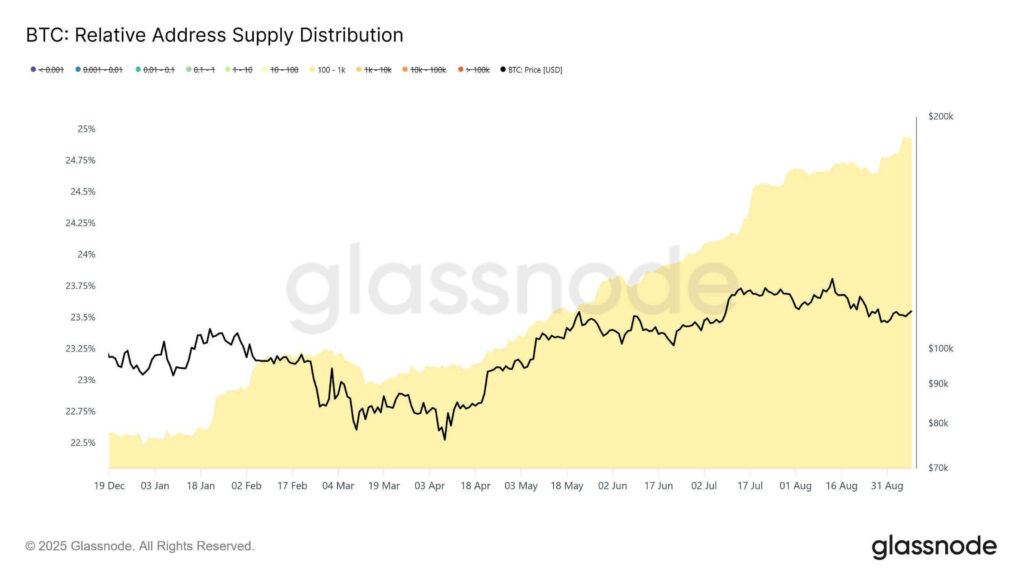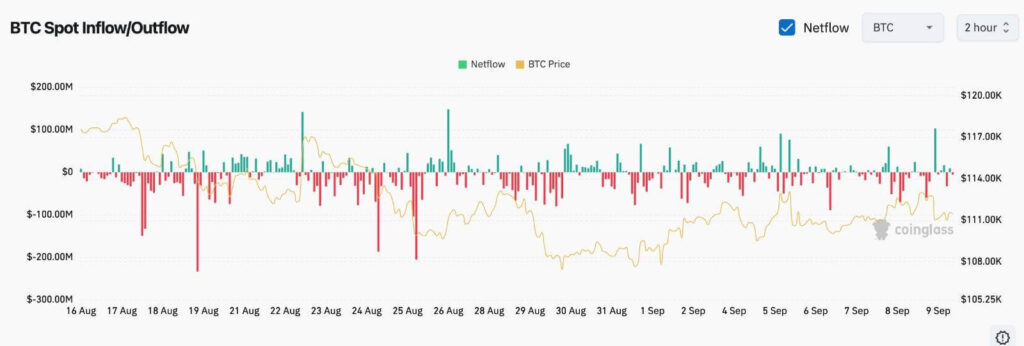Bitcoin whale accumulation is rising as mid-sized wallets (100–1,000 BTC) expand supply share to ~25%, while sustained exchange outflows remove liquidity. This reduces circulating supply on exchanges and supports price stability during consolidation, signaling continued long-term accumulation by non-exchange holders.
-
Mid-sized wallets (100–1,000 BTC) increased supply share from 22.5% to ~25%.
-
Exchange outflows exceeded -$200M on Aug 16–19, moving BTC to cold storage.
-
BTC rebounded from $108K to $114K (Sep 1–9) while net flows stayed negative, indicating reduced liquidity.
Bitcoin whale accumulation: mid-sized wallets reach record share; reduced exchange liquidity supports accumulation—read analysis and next steps.
Bitcoin whales holding 100 to 1,000 BTC hit record highs as exchange outflows tighten supply, supporting accumulation during consolidation.
- Mid sized Bitcoin wallets expanded supply share from 22.5% in December 2023 to nearly 25% by August 2025.
- Exchange outflows above -$200M between August 16–19 showed investors moving BTC to storage as price slipped to $110K.
- From September 1 to 9, BTC rebounded from $108K to $114K while net flows stayed negative, indicating reduced market liquidity.
Bitcoin wallets holding between 100 and 1,000 BTC have reached record highs, showing notable accumulation during recent market consolidation. This group steadily expanded its share of total supply from 22.5% in December 2023 to nearly 25% by late August 2025. This increase occurred while Bitcoin’s price fluctuated between $70,000 and $120,000, indicating continued growth of mid sized holders despite volatility.
What is driving Bitcoin whale accumulation?
Bitcoin whale accumulation is driven by sustained withdrawals from exchanges and increasing supply concentration in non-exchange wallets. On-chain metrics show mid-sized wallets growing supply share even as prices consolidated, suggesting accumulation rather than distribution by these holders.
How do exchange outflows affect supply and price?
Large exchange outflows remove available sell-side liquidity, reducing immediate market supply and supporting price resilience. Between August 16–19, outflows exceeded -$200 million on multiple days, indicating coins moved into cold storage rather than being sold on platforms.

Bitcoin holders chart, Source: Bitcoin Archive
Why did mid-sized wallets expand their supply share?
Mid-sized wallet accumulation likely reflects strategic accumulation by entities and knowledgeable investors during consolidation. These wallets boosted their share from 22.5% (Dec 2023) to ~25% (Aug 2025), a measurable shift in supply distribution that signals concentration among fewer holders.
What do net flows indicate about market liquidity?
Net flows show liquidity dynamics: persistent net withdrawals indicate coins leaving exchanges into custody, tightening market liquidity. From Aug 20–25 daily flows ranged -$50M to -$150M, and from Aug 26–early Sep outflows eased but still dominated at -$20M to -$80M, keeping liquidity relatively constrained.

BTC Spot Inflow/Outflow chart, Source: Coinglass
When did BTC price respond to reduced liquidity?
From September 1–9, Bitcoin rebounded from $108,000 to $114,000 while net flows remained slightly negative. The price recovery alongside continued withdrawals suggests buying pressure from holders and weakening sell-side supply on exchanges.
Frequently Asked Questions
How many mid-sized wallets increased their holdings since 2023?
Wallets holding 100–1,000 BTC expanded their supply share from 22.5% in December 2023 to nearly 25% by August 2025, reflecting significant redistribution of supply toward mid-sized holders.
What does a -$200M exchange outflow mean?
A -$200M outflow indicates substantial movement of Bitcoin off exchanges into custodial or cold-storage addresses, which typically reduces available liquidity for immediate selling and can support prices.
Key Takeaways
- Mid-sized accumulation: Mid-sized wallets now hold a larger share of BTC supply, signaling concentration and steady accumulation.
- Exchange withdrawals: Repeated large outflows in August reduced on-exchange supply and indicated coins moving to long-term storage.
- Liquidity impact: Net negative flows during price consolidation support reduced liquidity, which can amplify price moves when demand shifts.
Conclusion
On-chain data show Bitcoin whale accumulation—particularly among 100–1,000 BTC wallets—combined with sustained exchange outflows, has tightened market liquidity and supported price resilience. Investors should monitor net flows and wallet distribution metrics to assess whether accumulation continues and how it may influence future price action. COINOTAG will update this analysis as new on-chain data are available.
